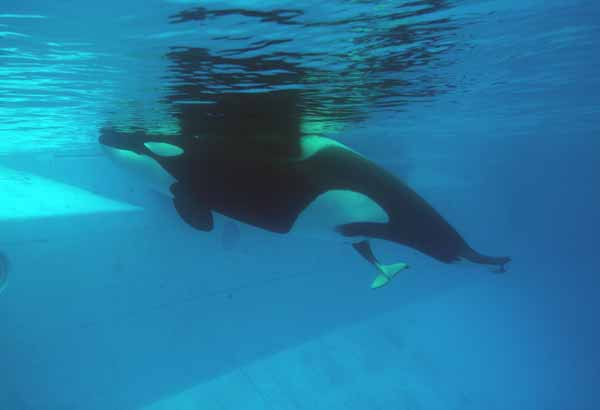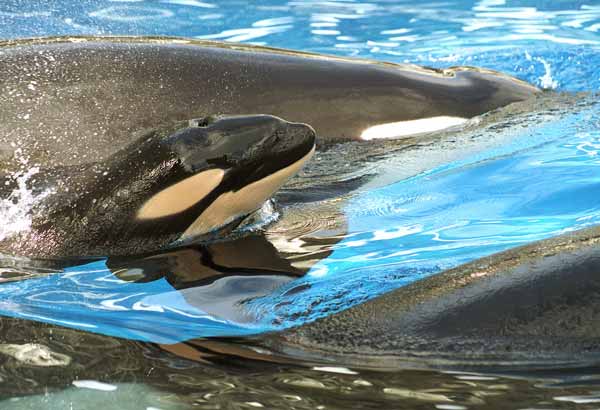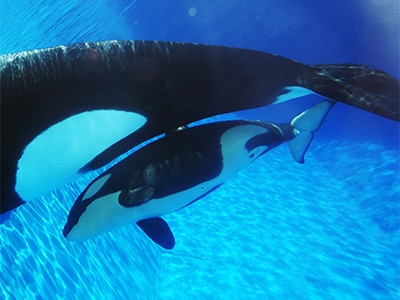Gestation
Killer whale gestation length averages 17 months, and ranges from 15.7 to 18 months at zoological parks.
Birth Seasons
Calves are born throughout the year, with no statistical evidence for birth seasons.
However, while males produced sperm throughout the year, peak testosterone and sperm production corresponded to months from March to June in North American zoological facilities.
Specific regions may have peak birth months. For example, in the northeast Pacific Ocean, many calves are born between October and March.
Calving
Just one calf is born at a time. Calves are born in the water.

Based on limited data collected from populations at SeaWorld and in zoological facilities, a female may bear a calf every 3 to 5 years. In some cases, a female may not have another calf for 10 years.
Calf at Birth
Size estimates of SeaWorld-born killer whales suggest that newborn calves are about 2.6 m (8.5 ft.) long and 120 to 160 kg (265 to 353 lbs.).
In the first few days after birth, the dorsal fin and tail flukes are flexible and pliable. They gradually stiffen.
The light areas of some young killer whales may be creamy white to pale yellow or tan rather than white. They usually turn white by the end of the first year, though some killer whales retain the yellowish color into adulthood.

Nursing
Most killer whale calves born at SeaWorld generally nurse for about a year, but may continue to nurse occasionally for as long as two years. This corresponds with observations in the wild.
Fat is an efficient source of energy to drive a calf's high metabolism. Killer whale milk is very rich in fat.
- The fat content of killer whale milk fluctuates as the calf develops.
- High-fat milk is an adaptation for calves to be able to quickly build a thick, insulating layer of blubber.
- Calves nurse for about 5 to 10 seconds at a time, several times an hour, 24 hours a day.
A whale calf suckles from nipples concealed in abdominal mammary slits.
Calves nurse below water, close to the surface. The mother glides in a horizontal position with her tail arched, and the calf swims on its side with its mouth on the right or left mammary gland.
Killer whale calves observed at SeaWorld began nursing several hours after birth. First successful nursing attempts ranged from 1.8 to 29.3 hours after birth.

Calves nurse for about 5 to 10 seconds at a time, several times an hour, 24 hours a day. Nursing frequency peaks the first day or two following birth, at about 45 minutes total average nursing time. As a calf becomes more adept at nursing and obtains more milk at each feeding, nursing time decreases dramatically to 10 minutes per day or less after three weeks and to 5 minutes or less by 2 months.
At SeaWorld, it's possible that first-time mothers may learn how to nurse their young by observing this behavior in other mother whales. Additionally, trainers teach them how to respond when their calf attempts to nurse.
Calf Development
Most calves grow about 64 cm (25 in.) during their first year, and they can gain about 400 kg (882 lbs.). They grow about 53 cm (21 in.) during their second year.

To conserve energy, the calf swims in the slipstream of its mother.
Births at SeaWorld
Killer whales have been born at SeaWorld parks in San Diego, San Antonio, and Orlando. SeaWorld's killer whale breeding program was the most successful in the world.
- Studying SeaWorld's killer whales, scientists have learned a great deal about killer whale reproductive biology and calf development. The data they've gathered from killer whale calves and their mothers could not have been obtained without close daily interaction and observation.
- In September 1985 a female killer whale calf was born at SeaWorld Orlando. The calf, named Kalina, thrived and reached adulthood. She is the first killer whale successfully bred, born, and raised in a zoological environment.
- In February 1993 at SeaWorld San Antonio, Kalina had a calf of her own — the first second-generation killer whale calf born in a zoological park.
- More than 30 calves have been successfully born and raised throughout SeaWorld's collection of killer whales.


SeaWorld experts have developed techniques for artificially inseminating killer whales. Artificial insemination (AI) occurs when semen that has been collected from a male is placed into a female's reproductive tract.
- The first killer whale born as a result of artificial insemination was born at SeaWorld San Diego in September 2001. The male calf was named Nakai.
- SeaWorld experts developed an intrauterine insemination technique using specialized medical instruments. They also developed a methodology for the collection and storage of viable killer whale semen.
- Veterinarians monitored daily urine samples to track hormone levels in adult female killer whales. This, combined with ovarian ultrasound examination, indicated when a female was about to ovulate. This information helped experts pinpoint the best time to introduce the semen.
- AI successes at SeaWorld require collaboration from SeaWorld veterinarians, killer whale trainers, animal keepers, and laboratory specialists.
- A critical component of a successful breeding program is maintaining genetic variability. Without AI, this meant transporting whales by plane between the SeaWorld parks, pairing different females with males, and hoping for successful mating. With the development of AI, managing genetic diversity has become easier. Instead of transporting an adult whale, semen samples can be sent from one park to another.
Successful killer whale births also have occurred at SeaLand of the Pacific (British Columbia, Canada), Marineland of Canada, Kamogawa Sea World (Japan) and Marineland of Antibes (France).




